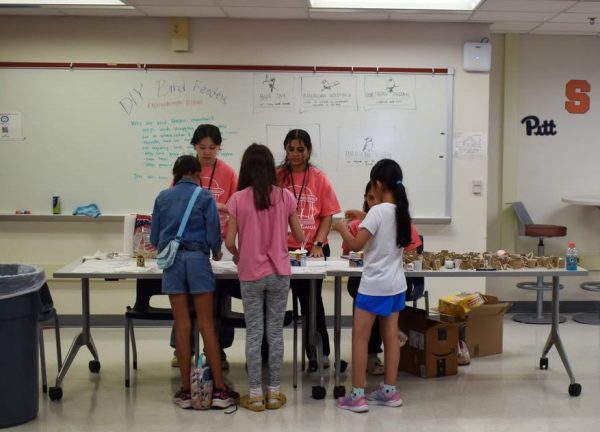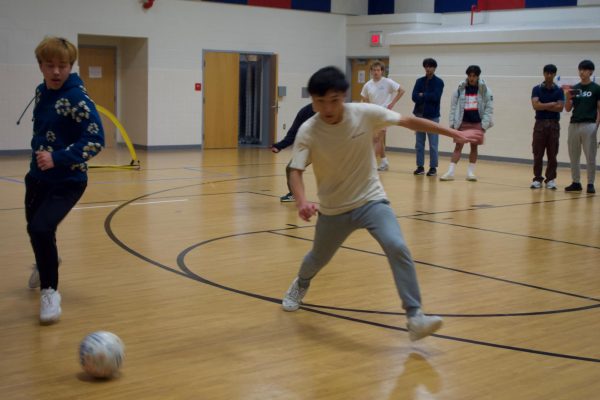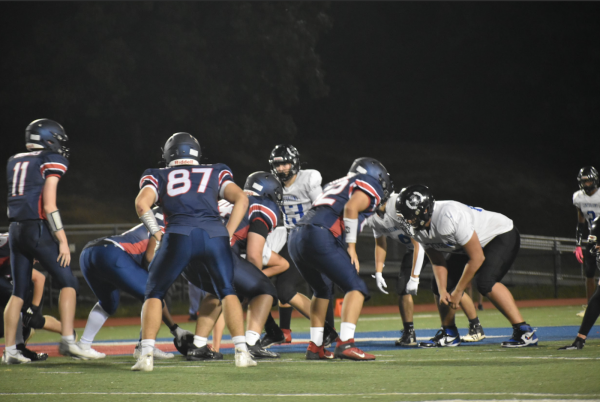Jefferson receives “AP Computer Science Female Diversity Award”
The development of a more welcoming and encouraging computer science environment at Jefferson has led to the achievement of the College Board AP Computer Science Female Diversity Award.
![Jefferson was a recipient of the "AP CS Female Diversity Award" from the College Board. "[A] noticeable difference is that before, the students who did the whole four year sequence of computer science in TJ were students who knew, coming in, that they wanted to study computer science," former computer science teacher Ms. Ria Galanos said. "Now, that's different. [Their elective choices] change from what they thought [they would be] six months ago, as they [realize], ‘Oh, I really do like this, and I had no idea I would’. That says a lot for the foundation's teachers–they're really encouraging [students with all types of] career aspirations. We don't expect people to become software engineers. We want some of them to become software engineers, but we also want them to become journalists, doctors, and lawyers.”](https://www.tjtoday.org/wp-content/uploads/2021/02/Project-Drawing-1_33-2.png)
Jefferson was a recipient of the “AP CS Female Diversity Award” from the College Board. “[A] noticeable difference is that before, the students who did the whole four year sequence of computer science in TJ were students who knew, coming in, that they wanted to study computer science,” former computer science teacher Ms. Ria Galanos said. “Now, that’s different. [Their elective choices] change from what they thought [they would be] six months ago, as they [realize], ‘Oh, I really do like this, and I had no idea I would’. That says a lot for the foundation’s teachers–they’re really encouraging [students with all types of] career aspirations. We don’t expect people to become software engineers. We want some of them to become software engineers, but we also want them to become journalists, doctors, and lawyers.”
“The field needs to be diverse. End of story,” former computer science teacher Ms. Ria Galanos said. “A field that’s making technological advances for humankind needs to have all kinds of humans working on that technology.”
After a gradual culmination of efforts put forth by teachers and administration, Jefferson has been awarded an “AP Computer Science Female Diversity Award” from the College Board; in the 2019-2020 school year, the percent of AP Computer Science (CS) exam test-takers comprised of girls exceeded the percent of girls making up the total Jefferson population. Of the 361 students taking AP CS, 39.6% were girls. Across the nation, there was a 37% increase to 1,119 awardees compared to the 2018-2019 school year. While girls compromise 56% of all AP exam test-takers and 46% of AP calculus test-takers, they compromise 19% of AP CS test-takers.
A brief history of women in computer science
When computing technology first arose in the mid-1900’s, the CS field looked a bit different. At that time, the number of women in the field was growing at an increasingly fast rate, possibly higher than that of men in the same field. From 1970 to 1984, the percent of women in CS had risen from 13.6% to 37%. These numbers quickly began dropping after 1984. Currently, there is no definite answer as to why this happened. One common theory points to the rise in targeted personal laptop ads, an invention that had just reached the markets and was commonly advertised towards men and boys, as well as perpetuated the “geek” stereotype.
CS opportunities at Jefferson
“TJ, itself, did not cause the gender disparity in the CS classes that existed when I arrived. That is 100% true because that happened in our society, and TJ was just mirroring it,” Ms.Galanos said. “I don’t know who made the decision to say, CS is a high school graduation requirement, but those people that had that idea, and then supported it, were forward-thinkers. This was in 1985, and they did the right thing. What happened is that as time went on, less and less females were taking the second and third and fourth year classes, most likely because of a reflection of what was happening in the United States.”
Forty five percent of high schools teach CS. What sets Jefferson apart from other schools is not only the fact that they offer CS, but the depth of learning provided through classes such as Artificial Intelligence, Automation and Robotics, and research labs or mentorships. Moreover, at this STEM school, there are a number of CS-centered opportunities, ranging from events like HackTJ to clubs like CyberPatriot.
“The most unique thing to me [about Jefferson] is that [the students] are not satisfied if what they’re hearing is something they already know,” Ms. Galanos said.
A few people behind the change
Before coming to Jefferson in 2012, Ms. Galanos had been teaching computer science in Georgia. In 2011, 400 students in the entire state of Georgia took the AP CS exam–Ms. Galanos had taught 125 of them.
“My favorite [part about teaching] is any student who doesn’t think they can do something, by providing them the tools or the resources or the knowledge, they’re able to then do it, and they feel confident and successful to keep doing that thing,” Ms. Galanos said. “It’s just giving them permission to dive into something, and being there as a net in case they need it.”
In Ms. Galanos’ perspective, student choice was the greatest contributing factor towards Jefferson reaching this awarded benchmark. Student choice allows students to explore the multitude of applications of computer science, and to realize that there is no singular type of CS personality. This concept was instilled through proposing new classes such as Mobile App Development and Web Development, as well as simply encouraging students to be more creative in the classes that were already offered. For instance, in Foundations CS, instead of asking students to replicate the video game Pong as they had done in previous years, they asked students to build their own versions. Likewise, they incorporated the Twitter project into AP CS, in which students were instructed to create their own CS project involving tweets.
“It didn’t take a lot of convincing to make [these] small changes. It only took convincing, that a small change can make a difference. One hundred of them together, ended up where we are at a place where this AP course, which is not the required course, reflects the diversity of the school, at least, where gender is concerned,” Ms. Galanos said.
She emphasizes that the support of the administration in constructing a system in which teachers can propose and execute classes in unique ways has particularly contributed to their success. Outside of the classroom, Ms. Galanos was the HackTJ sponsor–in which 37% of participants for the 2018-2019 HackTJ were girls– and also created the ladies coding club Coding Lady Colonials (CLC).
“Lots of people would say to me, ‘well, isn’t [Coding Lady Colonials] biased against men’, and [I say], [men] can come,” Ms. Galanos said. “We’re not talking about things related to females, we’re talking about the field and opportunities. It bonded them and encouraged them. It’s not like that club was doing anything that was magic. It was just saying you are welcome to be here. This is the place for you, and if you’re interested, you’re not alone.”
At CLC, they teach coding languages such as Python or HTML, cover Olympiad content, bring in guest speakers, and have coding-centered holiday parties. For instance, for their Christmas holiday party they had participants program a Christmas-related website. CLC generally has 30 to 40 members every meeting.
“Usually, we get a ton of freshmen at Coding Lady Colonials, and I think [Coding Lady Colonials] keeps that interest and momentum going. Most freshmen enter TJ and take some entry level computer science course, which is great–but then once they come to Coding Lady Colonials, they see more girls like them and think, ‘wow, we can do all this cool stuff later on in the year, and I can expand my knowledge of Java and Python’, and then they’re motivated to take AP computer science and continue their computer science journey,” CLC president senior Amber Garcha said.
Occasional CLC attendee and 2021 NCWIT Award for Aspirations in Computing recipient senior Eban Ebssa first began coding in Foundations Computer Science during her freshman year. Her favorite part about coding is its problem-solving aspect. At Jefferson, she has taken classes such as Bioinformatics and Artificial Intelligence. Though she appreciates Jefferson for all of the opportunities and shared student motivation it provides, she notes some drawbacks.
“It can also be very competitive… and being not only a woman in CS, but a black woman in computer science at TJ, some people don’t expect me to be the kind of person to do CS,” Ebssa said. “It takes a toll on my confidence, but at the same time, I know that by continuing CS because I love it is going to stop people from saying things like that because the more inclusive and diverse the CS field becomes, the less likely people are to say ‘you don’t look like it’, because then there won’t be any stereotype for people in CS.”
One teacher in particular has been influential in her decision to continue her path in CS.
“I really appreciate [Mr. Eckel’s] lectures, and how he doesn’t only teach us the algorithms, but he is also just a mentor overall and teaches us about life. I appreciated that, and seeing him and seeing other amazing teachers at TJ makes me also think that I might want to become an educator one day.”
Ms. Nicole Kim, the only woman teaching computer science at Jefferson since Ms. Galanos left in 2019, experiences a similar proportion of gender disparity in her field.
“I don’t feel that way, actually. The [other teachers] listen to my ideas, because I usually have a different viewpoint than most of the guy teachers,” Ms. Kim said when asked what it is like to be the only woman teaching CS at Jefferson.
Mr. Dan Tra, who was chosen to represent teacher of the year for Jefferson–and is the first CS teacher in Fairfax County to be selected for this award–, reflects on his experience as an ally for women in computer science.
“I was in an event where I took a large number of girls to a training session. There must have been 250, girls and adult women there. I was the only male,” Mr. Tra said. “Because the organizers really knew me and had worked with me on a lot of things, they invited me to give a comment in front of everybody. I wanted to just talk in the back, but no, I had to come up front. I looked around, [and thought], ‘so this is what it was like it was like to be the only one, right?’ To go through that, was to experience what it might be like for a girl to walk into a computer science classroom in college where she’s one… in a class of 200 or 300.”
In the past, he established and grew CS initiatives at Falls Church High School and W.T. Woodson High School by writing letters to students, making posters, slides, and videos, as well as attending events like football games and band performances to speak about CS to parents and students.
“The kids came up with an idea that we make this huge banner, and if you were signing up with computer science, you would put your name on it. Everybody came into the room and signed up, and it was so much fun because you can watch the list grow. It was weird, the guys didn’t really put their names up, even though they signed up, but almost every girl that signed up decided to put their name on that list. I think it was empowering because … [it showed them that] they’re not going to be the only girl in my class… The county national average is around 12% female participation–we had over 40%,” Mr. Tra said.
He believes that a student’s first experience in CS, i.e. the introductory course, defines their perception of the field in the future. At Jefferson specifically, he reasons that there may be a drop in the number of students taking CS past the foundations course because of the rigorous way in which it is taught, and that it is important to have engaging teachers who help students discover the “fun” side of CS.
“Within our department, Dr. Torbert, [the CS department head], says ‘hey, you got an idea, go for it.’ He is completely supportive. He believed that it was going to make a difference, and he totally welcomed it,” Mr. Tra said. “The other teachers who are on my team are supportive [as well]. I [would say], ‘let me try this, and then we’ll bring it on as a team the following year.’ They’re like, ‘no, let’s do it let’s just do it all together’. We have a CS department. Most schools don’t.”
The impact
“I was happy, because [winning this award] shows us that progress is being done,” Ebssa said. “Computer science education is becoming more equitable. I think that TJ will be more encouraged, having earned this award, to continue supporting women in STEM and women in computer science because TJ is kind of a role model for other high schools too. I think seeing that one of the top high schools in the nation can achieve this is very inspiring to other schools.”
Like many others, Ms. Galanos hopes that they are able to sustain this number.
“What’s the next goal? It’s to get the junior year classes to that level, and then the senior year classes, and that might take another five years.”
One thing, however, is clear: this diversity is vital to innovation, and actively trying to achieve diversity is beneficial to the population as a whole.
“If you provide CS opportunities, you’re just by nature going to increase the number of girls who get to participate. And that’s the bottom line,” Mr. Tra said. “I am championing the concept of computer science for all. Even though I’m aiming it at girls, it grows the opportunity for everybody.”
Maintaining the momentum
With the virtual school year bringing new challenges and a shifted focus, it has been difficult to maintain this momentum.
“Right now, I’m just trying to provide focus virtually… I’m not as responsive to the connections that I had before because it’s just time and energy that I don’t have because it’s virtual,” Mr. Tra said.
A few students have ideas on how teachers can foster a more positive atmosphere both virtually and in-person. One manner includes introducing CS in a less intimidating way. For instance, during curriculum fairs students typically sign up to learn more about a course that they may potentially take the following year. The classrooms, however, are filled with an overwhelmingly large number of people, often leaving little time for students to interact one-on-one with teachers and learn about the aspects of CS that they would personally enjoy. Smaller session sizes may solve this concern. This one-on-one interaction, along with a collaborative environment where students are encouraged to brainstorm with the students around them, can be carried to the actual courses themselves as well. Additionally, adding more flexibility to the curriculum similar to how they have done so with previous projects such as the Pong game may better inspire creativity and establish a connection between the student and CS. Finally, continuing to concentrate on the idea of a growth mindset may be beneficial, especially for students who are on the verge of deciding whether CS is something that they want to pursue in the future.
“We grow a little bit each year, and then at some point, we actually hit what we were aiming for,” Ms. Galanos said. “And all we were aiming for is that when you walk into a computer science classroom at TJ, you don’t immediately say, ‘Oh, this must be computer science, because I see no women.’ It [would] just look like the rest of the school.”


![New weapons detectors were installed this morning through a pilot program required by Superintendent Dr. Michelle C. Reid after an incident at West Potomac High School. “These threats [have] only happened once, but you can never really know when [it will happen],” junior Laura Moreno Hernandez said. “I think this precaution, if we get used to it, will be [fine]. It’s better to be safe than sorry.”](https://www.tjtoday.org/wp-content/uploads/2025/06/IMG_9022-e1749223594242-600x364.jpeg)

![Students take taffy from the tables in Nobel Commons. “Get the word out and let everyone know,” principal Michael Mukai said. “We want to share this moment before we go away [for spring break].”](https://www.tjtoday.org/wp-content/uploads/2025/04/IMG_4372-600x450.jpg)

![Students and teachers at the town hall passionately spoke about issues that were brought up, such as the retake policy, the 70/30 split between summative and formative grades, and academic dishonesty. “Every single month, we go to something called the Superintendent Advisory Council meetings that address county-wide issues, for example, the 70/30 split with the summatives and formatives that’s going on right now as well as other [issues] you all have,” senior SGA secretary Jaydon Son said.](https://www.tjtoday.org/wp-content/uploads/2025/03/IMG_8917-600x400.jpg)
![A group of juniors play “Clash Royale” on their phones during lunch. Lunch is the only time when phones are allowed to be out. “I think once we adapt to it, it's not going to be something we miss because [for] everyone moving forward, that'll have been the policy [since] middle school,” DNA science and biology teacher Aubrie Holman said.](https://www.tjtoday.org/wp-content/uploads/2025/09/IMG_6621-2-e1758016994220-600x479.jpeg)
![Art therapist Katherine Pedrick and senior Viola Pande pose for a picture in front of the art therapy banner at the Children’s National Hospital’s annual Sunflower Festival, where Pande distributed the art kits that she made for her Gold Award. “Art is so multifaceted,” Pande said. “Even though I'm doing physical art— and I think physical art is really therapeutic because you are painting or coloring—art can come in many different forms. I’m combining music and physical art in [my Gold Award]. Music has been a really helpful form of therapy for me throughout my high school years and throughout my life in general because I can pour my energy into something that's not school. It’s also creating something [that isn’t] physical or visual.”](https://www.tjtoday.org/wp-content/uploads/2025/09/viola-image-406x600.jpeg)


